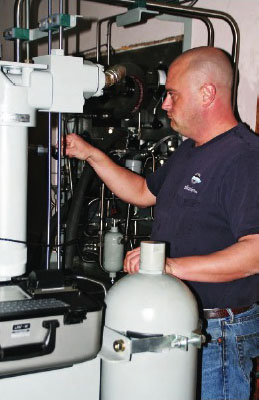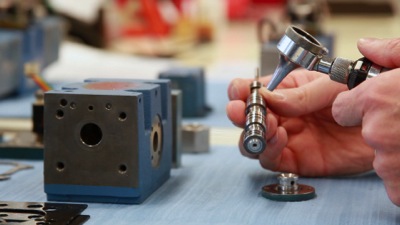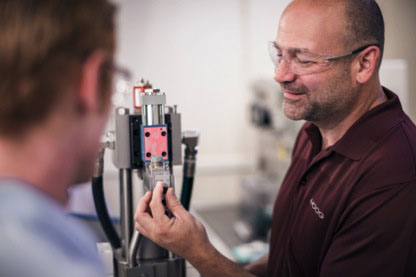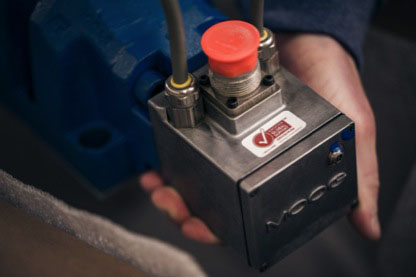Performing pre-emptive, scheduled maintenance is the key to not only extending the life of your machine but also reducing downtime and ensuring quality parts are delivered over the long term. Long-term productivity can also be enhanced by decisions made by the OEM when a machine is in the design phase. This article discusses ten tips that are useful for both machine builders and machine owners to know about optimizing servo-hydraulics.
Maintaining equipment for long term productivity is a team effort. Typically, responsibility rests solely on the facility’s maintenance staff. This is actually a shared effort between the machine owners—including the engineers and purchasing professionals who specified and purchased the machine—and the machinery OEM and sub-suppliers who designed the equipment.
In today’s competitive environment, machinery builders (OEMs) must pay close attention to costs, and typically build-in a set of standard required features in a new machine with the ability for customers to add optional items to enhance operations or improve maintainability. When purchasing new machinery it is critical for the maintenance team to have input on the features they need to ensure the machinery will continue to operate with the same precision and productivity rates as when it was new.
This article shares the experience that Moog engineers, product designers and support professionals have gained over many years in a range of applications. These ten tips can help you to use planned maintenance to ensure optimum reliability, productivity and precision of your machine.
1. Commit to fluid cleanliness
Moog often works with engineers from machine builders who are looking for improved speed, precision or reliability for their machines. The total machine system may have dozens of hydraulic control components and Moog products are often found on the most critical axes. Consequently we need to partner with our customers to find practical ways to ensure motion control products keep running like when they were new.
The servo valve also has extremely small parts manufactured to very tight tolerances. Precision is necessary to meet the performance objectives of a machine and ensure it achieves the desired product quality or production throughput. A commitment to hydraulic fluid cleanliness is the first step to maintaining a productive machine.
What does clean mean? ISO standard 4406 measures cleanliness as the quantity of particles at different sizes in fluid. There are two ISO 4406 cleanliness standards for servo valves. The first, 14/11 (ISO 4406:1987) or 17/14/11 (ISO 4406:1999), allows the valve to function as designed with an average wear rate. The second standard – offering extended life and performance – is: 13/10 (ISO 4406:1987) or 16/13/10 (ISO 4406:1999).
If the hydraulic power system is integral to the machine, the OEM must supply filtration equipment that will maintain cleanliness to the above levels. If a centralized system is utilized, a filtration expert should be consulted to make certain it meets these requirements.
2. Analyze oil regularly
The price of analysis has dropped considerably with laser particle count technologies. Request one monthly. After three consecutive passing grades, slowly increase the period between analyses. Remember to analyze at least once per quarter. Machine builders can aid in this process by providing the necessary connections to facilitate particle testing and providing the connections in an accessible area. If these connections are optional items, the user should specify that they be included in the RFQ.
Remember to include a water content analysis if continuous water monitoring equipment is not installed in your system.
3. Double-check your oil analysis
The accuracy of a laser count can deteriorate whenever there is a high degree of variability in particle size. Smaller particles can go undetected behind larger particles, which shield them from a laser count, so check the results at least annually with the patch-count method. With patch-count, a technician runs fluid through the patch and counts the different sized particulate. The patch-count method can detect particles two micrometers and larger.
The machine builder should provide a fluid access point downstream of the filters to facilitate the oil sampling process. The ideal location would be in close proximity to the servo valve or actuator.
Service technician uses portable laser particle counter to determine if hydraulic oil is within ISO compliance standards.
4. Use proper filter elements
Use a filter element that filters the fluid to the required standard. If full-flow elements cannot meet your system requirements, consider adding a kidney loop filtration system. Some purchasing departments will focus on the filter element’s size and not understand the ISO standard you are trying to meet. In so doing, they will source a less expensive filter, but it will not be designed for your needs. Always check filters prior to installation to ensure they meet the requirements. If in doubt, your local Moog distributor or support professional is experienced in filtration and the required cleanliness standards, and they will gladly audit your system.
Installing a kidney loop filtration system is a cost-effective way to clean oil to a micron level not always feasible in a full-flow system. They can be dedicated to a given machine, or portable units that can be cycled from one machine to another.
While we would not expect machine builders to offer kidney loops as a standard feature, if there are optional taps to connect such a system at a later date, we would recommend that this capability be considered when purchasing a new machine.
5. Maintain dry hydraulic fluid
Water contamination in a hydraulic system can be problematic. It can affect the physical and chemical properties of the fluid. In addition to corrosion, components relying on the hydraulic fluid for lubrication may experience shortened lifespans.
Water ingress into the hydraulic system can come from a variety of places, one of the simplest to address is through air breathers installed in the hydraulic system.
Poor breather maintenance leads to contaminated fluid. All hydraulic systems have tanks with a breather to filter the air that enters. In some cases, workers will remove the breather because these components become clogged and interrupt operation of the system, especially in a work environment with a lot of dirt and dust. By doing so, they are ignoring the purpose of the breather.
There are many breathers for any given environment, including integral desiccant systems to help prevent water ingress into your reservoir or crankcase. Your local Moog distributor or support professional can assist you to evaluate breather requirements.
Machine builders will normally supply a breather suitable for a standard industrial environment. If you are purchasing a new machine, review your specific ambient environmental conditions with the machine builder to ensure you have the right breather for the application.
This is one of many preventative maintenance steps to prevent water ingress. If you already have water in your fluid there are a variety of methods available to remove it, some more expensive than others.
6. Drain, clean and flush when changing oil
The process of changing oil stirs up particulates and debris. Servo valves may experience issues at start-up caused by the added contamination in the piping. To alleviate start-up issues, drain the system and clean the sump whenever changing oil. Install flushing blocks on servo and proportional valves to bypass this equipment during commissioning to clean the fluid prior to start-up.
Sump clean-out access may be an optional feature. If not purchased, it places the maintenance team at a disadvantage. When purchasing new equipment, specify this feature and review equipment drawings to ensure the sump can be cleaned without major disassembly.
Machine builders should design the manifold systems to provide enough clearance to allow mounting of flushing blocks, even if these items are not available through the machine builder at the time of purchase. Your local Moog distributor or support professionals can audit the machine and quote flushing blocks upon request.
7. Filter new oil
Do not assume new oil is clean enough for a system. Filter new oil to meet the system requirements before pumping it into the reservoir. Keep in mind that brand new oil does not meet the recommended ISO requirement, since it is usually 18/12, not the 13/10 or 14/11 needed for operating precision equipment.
To this end, machine builders should maintain the same cleanliness standards in their test areas.
A technician inspecting spool land edges for signs of wear or erosion on a proportional flow control valve.
8. Monitor the system with predictive maintenance
Many companies monitor servo valve performance by recording the amount of current it typically takes to hold the actuator or system mid-stroke or at null. Technicians place minimum and maximum limits around the current and track the performance over time.
For example, a 10-milliamp (mA) valve might operate at 5 mA to hold position at null in a closed-loop system. The limit could be +/- 1.5 mA. If the current passes over the established threshold, check the valve or system for contamination in the servo valve or friction in the actuator and/or system. By establishing a baseline for a machine while new or newly refurbished, plant managers can monitor performance over time to prevent the next major breakdown.
If a manager does not have someone on staff experienced in developing a predictive maintenance program, then the manager could contact Moog or the machine builder for assistance.
Machine builders may have this diagnostic capability available as a standard or optional feature. When purchasing new equipment this feature will reduce costs and improve availability long term. If you have an existing machine without this capability, Moog makes a variety of valve testers to serve this function. Contact your local Moog distributor or support professional for more information or a demonstration.
9. Diagnostic Training
Unfortunately servo valves are often considered a mystery. Treated as a “black box,” common trouble shooting techniques are to replace the servo valve early in the process. This often leads to a servo valve of “suspect” condition which may be placed into your inventory as a “good” valve.
Moog offers training, either on-site or in our factory to familiarize maintenance technicians with the functionality of the valve and how to utilize valve testers and other tools to determine if the valve is indeed the root cause of the issue. We also train on proper storage and handling techniques to ensure the valve on the shelf is ready for installation on your machine.
A technician receives hands-on training from a Moog maintenance expert.
10. OEM repairs
Moog is the only authorized repair center for servo and proportional valves. We work with the OEM of the machine to custom design our valves to meet exact requirements. Only Moog has the design specs for each of our thousands of different valve models, and only Moog has authentic replacement parts and certified technicians to ensure your repaired valve functions as a new one.
All Moog Servo Valve repairs done through Moog or a Moog Authorized distributor are repaired to the original specifications. Even if your valve only requires a Level A “Clean and Calibrate” service, products are returned with renewed warranty. Over time we have seen many situations where poor quality repairs by local repair houses result in poor machinery performance and reliability.
Your local Moog distributor or support professional can also perform a facility audit. A thorough review of your inventory can result in model substitutions, reducing the number of different models and spare valve requirements. These modifications can be made as repairs are needed, eliminating the needed for a capital program.
A Moog Global Support label indicates the servo valve will provide “as new” performance after authorized maintenance.
AUTHOR
Steven Beddick is an aftermarket specialist for Moog Industrial Group, a division of Moog Inc. He has nearly 30 years of experience with application engineering support for industries ranging from automotive to power generation. Beddick holds a bachelor’s degree in electrical engineering from Grove City College. Contact him at sbeddick@moog.com.






